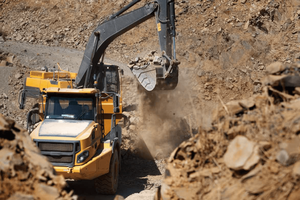Seals and hoses made from fluoroelastomers
Featured Product from AGC Chemicals Americas, Inc.

Heavy Equipment
Seals and hoses made from fluoroelastomers tolerate the engine lubricants, hydraulic fluids and diesel fuel products used in heavy machinery. A variety of chemicals and additives are often incorporated into fuel to enhance performance. The superior chemical resistance of fluoroelastomers guards against seal and hose deterioration.
General Industry
O-Rings and seals used in oil and fuel systems, pumps, valves, and tanks within industrial equipment are fabricated from fluoroelastomers to ensure their reliability, safety, and durability in high-performance applications.
Industries Rely on Fluoroelastomer Chemical Resistance for Optimum Product Performance
Fluoroelastomer chemical resistance is an important performance quality when it comes to manufacturing parts with chemical stability. Fluoroelastomers offer superior characteristics over silicone and other synthetic rubbers.
What sets fluoroelastomers apart is their unique molecular structure polymerized with fluorine. These types of elastomers provide extraordinary resistance to high-temperatures and highly active alkalis, hydrogen sulfide, solvents, acids, and other industrial chemicals.
They also exhibit outstanding resistance to heat, chemicals, fuels, ozone, and steam. Chemical resistance, however, is one of its most desirable traits for products and parts subjected to harsh operating conditions.
According to a study conducted by SkyQuest, the fluoroelastomer market is on a growth trajectory, projected to grow from $1.35 billion in 2022 to an estimated $1.94 billion by 2030.
This surge in demand is attributed to the excellent chemical and heat resistance offered by fluoroelastomers. In a world where countless industries seek to enhance the chemistry of their products to thrive under adverse conditions, fluoroelastomers emerge as materials of choice.
Real-world applications benefiting from fluoroelastomer chemical resistance
Originally developed for aircraft and aerospace applications such as seals in engine and fuel handling systems and O-rings in hydraulic systems, fluoroelastomers have since become a primary choice for manufacturing seals across various industries including automotive, fluid power, semiconductor, and oil and gas. Below we’ll explore some real-world applications that rely on the chemical resistance of fluoroelastomers.
Brands of Fluoroelastomers
FKM, FEPM, and FFKM* are common fluoroelastomers, each possessing unique characteristics. While FKM is classified as a fluoroelastomer, FFKM is known as a perfluoroelastomer as it contains higher amounts of fluorine for improved chemical resistance. FEPM or tetrafluoroethylene propylene, has a partial fluorinated content. It displays exceptional chemical resistance, especially to acids, brake fluid, CO2, alkalis, and amines in comparison to FKM.
AGC offers the AFLAS® FEPM, Type IV FKM and FFKM grades listed in the table below. They are the material of choice for parts and components that need to perform reliably in the world’s harshest environments.
Choosing a grade of fluoroelastomer depends on application requirements, cost, and other factors. For example, while FFKMs exhibit the ultimate in sealing performance in all aggressive environments, FKM offer a good balance between performance and cost.
As the only manufacturer of AFLAS resins in the world, AGC provides guidance in choosing the right fluoroelastomer for an application. These products provide unequaled fluoroelastomer chemical resistance.
Follow us on:
Watch>>>AGC Group Overview
ABOUT AGC CHEMICALS AMERICAS
For almost a century, AGC Chemicals has been manufacturing high-performance materials serving industrial customers. Already the world's largest, longstanding custom compounder of PTFE and other fluoropolymer resins, AGC continues to build its product line with the introduction of FFKM resins that meet the growing demand for tougher, more durable products for today's production and manufacturing environments.





